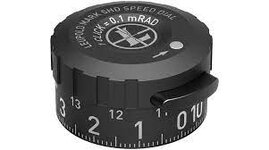mil is superior for what? this is a forum within the backpacking hunting section ya?

when you gotta throw that pack down and send it on your ram at 600 yards before he rolls over the top you'll have a hard time beating a guy with a speed dial turret and knows his windage in inches for typical wind speeds.... range, dial to the range, hold into the wind and send it...very quick, very simple, that is the best formula for hunting
for target disciplines anything goes...make it as complicated and gizmo intensive as you want
but for hunting to 600...there is a far faster simpler way to set up and get it done, the speed dial turret set middle of your elevation temp ranges putting you out no more than a click or two at your max range (still kill zone from antelope to bighorns), 10 mph wind hold in inches for 300, 400, 500 and 600 yards (4 numbers in a decal under eye flip cap or on side of scope tube to memorize)... 3", 6", 12" and 18") makes for very quick field calcs and you simply range, dial to range, you've likely been paying attention to wind all day and you can flop down over that pack and send it to kill zone likely twice as fast as the guy set up for some target discipline and he will do it solo as well, all you need is a rangefinder that spits out range...nothing else, still haven't seen anything faster or more 'hunt' friendly/effective...go beyond 600 routinely though and then can see the need for finer data and set up
range 450 yards, dial to 4.5, wind approx. 5 mph, hold into wind about 5"....send it, watch ram fall
range 575 yards, dial to 5.75, wind 15 mph, quick math it and hold into wind a about 2 1/2' feet and send it, watch ram fall
not much is quicker than paying attention to wind while you're hunting and knowing 4 key 10 mph holds which is all that's required as it's not a thing inside 300, just hold a couple inches into a nasty crosswind and you're good for 300 or less, dead critter, and mathing 5 mph increments and 25 yard increments from those 4 key numbers is super simple and super fast
also, the guy who's practiced with whatever system he chooses will be more effective than guys who aren't...but if you have two guys practiced going head to head, the guy who chooses the simplest system will be the fastest to dead ram

and there's nothing simpler than the outlined set up here for 0-600 yard hunting
not easy to sell a bunch of expensive gear though if you keep it simple like that, watch out for the marketing machines telling you all you need if you wanna be able to hunt out to 600 yards, there's a few ways to skin the cat, learn about them all and then see what is best for you
they should have a 0-600 yard prs division, no charts or ballistic programs allowed, only a rangefinder that doesn't even do angle comp and that's it...you know...like real hunting situations for solo backcountry hunters haha, getting the elevation right being the easy part, small part knowing how to visualize true horizontal distance but the bigger part would be how well you know your wind and quick math of about 4 memorized numbers...call it the 'best of the west' division lol, or just the 'hunting' division, heck maybe even funner would be the 'dead battery' division and you can't even use a rangefinder....that sounds super fun actually

